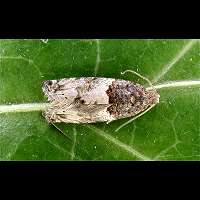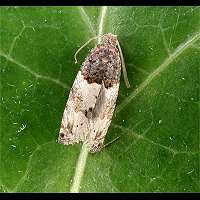Poplar Shoot Borer (Gypsonoma aceriana)
It is a nasty business trying to identify the Poplar Shoot Borer. The first part of the wings is darkened, the later part is whitish. Within the white part are some smears and markings, but none of them is very distinct. And that's the best way identifying this species. Almost all similar, bird droppings imitators, usually have one or more distinct features. The Poplar Shoot Borer is the exception. Also note the greyish face, for it may help you identifying this one. Always try consulting a specialist, for chances are you're wrong! Adult moths have a wingspan from 12 to 15mm.
The eggs are being deposited in summer. The small caterpillars bore into twigs of the foodplant. When growing, the caterpillars move on to fresh shoots. These don't develop well and often galls appear. Usually damage done isn't very great, but when appearing in great numbers, the moth may infest up to 90% of all shoots, causing considerable damage. Like the name implies the Poplar Shoot Borer is only found on a number of Poplars, including some garden varieties.
The Poplar Shoot Borer flies by night only. It is on the wing in July mainly. This period is much longer on the continent, though. Is attracted to light in small numbers. May not have been identified correctly all the time. A rather common species over much of Europe and the United States, where it was introduced unintentionally. In Britain only common in southern parts of England and Wales. Elsewhere rare, getting even rarer going north. Nearly unknown from Ireland and Scotland.
It is a nasty business trying to identify the Poplar Shoot Borer. The first part of the wings is darkened, the later part is whitish. Within the white part are some smears and markings, but none of them is very distinct. And that's the best way identifying this species. Almost all similar, bird droppings imitators, usually have one or more distinct features. The Poplar Shoot Borer is the exception. Also note the greyish face, for it may help you identifying this one. Always try consulting a specialist, for chances are you're wrong! Adult moths have a wingspan from 12 to 15mm.
The eggs are being deposited in summer. The small caterpillars bore into twigs of the foodplant. When growing, the caterpillars move on to fresh shoots. These don't develop well and often galls appear. Usually damage done isn't very great, but when appearing in great numbers, the moth may infest up to 90% of all shoots, causing considerable damage. Like the name implies the Poplar Shoot Borer is only found on a number of Poplars, including some garden varieties.
The Poplar Shoot Borer flies by night only. It is on the wing in July mainly. This period is much longer on the continent, though. Is attracted to light in small numbers. May not have been identified correctly all the time. A rather common species over much of Europe and the United States, where it was introduced unintentionally. In Britain only common in southern parts of England and Wales. Elsewhere rare, getting even rarer going north. Nearly unknown from Ireland and Scotland.






